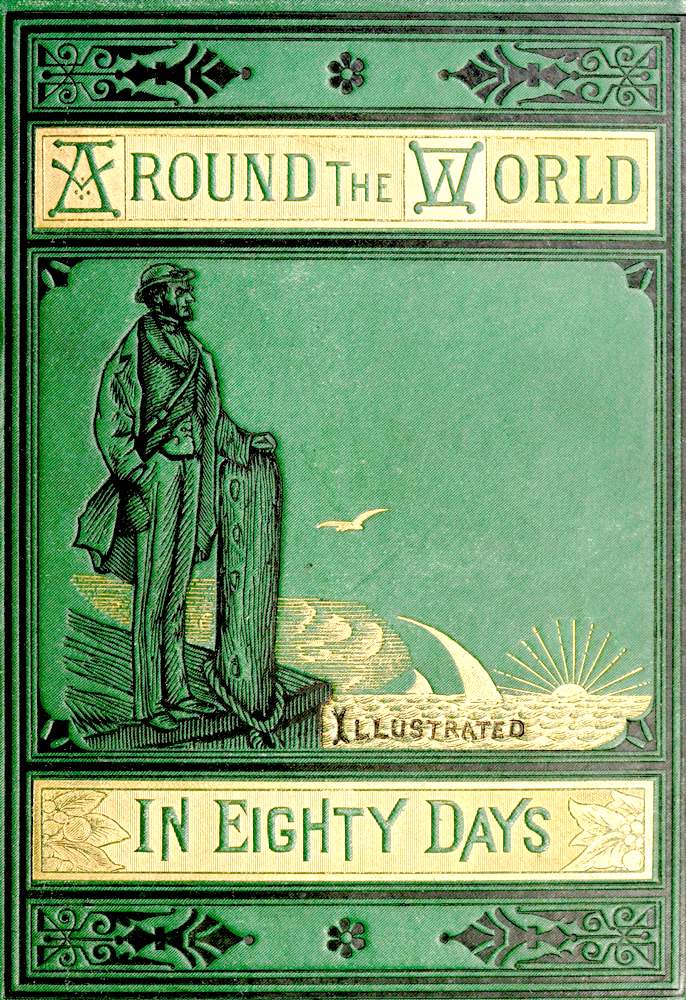|
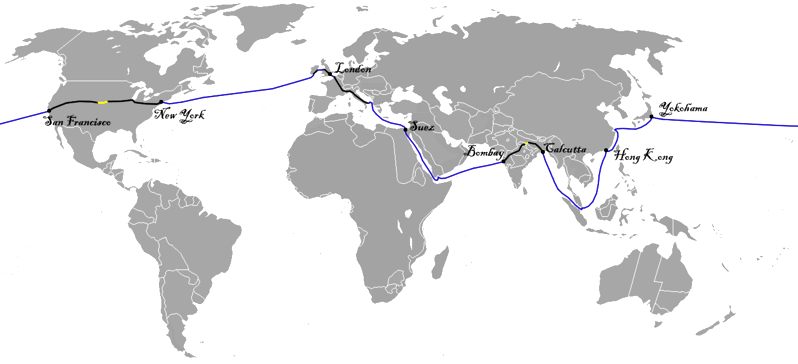
Map
of the route taken by Phileas Fogg, starting in London, then proceeding
east to Suez, Bombay, Calcutta, Hong Kong , Yokohama, San Francisco, New
York, and across the Atlantic
ocean to Ireland, then Liverpool England, and back to London. The route
planner below is for a circumnavigation on water in under 80 days, using
hydrogen, as per the author's prediction in The Mysterious Island. It
would be a major achievement if this was arranged to honor the 150th
anniversary of his publication.
<<<<
CHAPTER XXIII.
IN WHICH PASSEPARTOUT’S NOSE BECOMES OUTRAGEOUSLY LONG
The next morning poor, jaded, famished Passepartout said to himself that he must get something to eat at all hazards, and the sooner he did so the better. He might, indeed, sell his watch; but he would have starved first. Now or never he must use the strong, if not melodious voice which nature had bestowed upon him. He knew several French and English songs, and resolved to try them upon the Japanese, who must be lovers of music, since they were for ever pounding on their cymbals, tam-tams, and tambourines, and could not but appreciate European talent.
It was, perhaps, rather early in the morning to get up a concert, and the audience prematurely aroused from their slumbers, might not possibly pay their entertainer with coin bearing the Mikado’s features. Passepartout therefore decided to wait several hours; and, as he was sauntering along, it occurred to him that he would seem rather too well dressed for a wandering artist. The idea struck him to change his garments for clothes more in harmony with his project; by which he might also get a little money to satisfy the immediate cravings of hunger. The resolution taken, it remained to carry it out.
It was only after a long search that Passepartout discovered a native dealer in old clothes, to whom he applied for an exchange. The man liked the European costume, and ere long Passepartout issued from his shop accoutred in an old Japanese coat, and a sort of one-sided turban, faded with long use. A few small pieces of silver, moreover, jingled in his pocket.
“Good!” thought he. “I will imagine I am at the Carnival!”
His first care, after being thus “Japanesed,” was to enter a tea-house of modest appearance, and, upon half a bird and a little rice, to breakfast like a man for whom dinner was as yet a problem to be solved.
“Now,” thought he, when he had eaten heartily, “I mustn’t lose my head. I can’t sell this costume again for one still more Japanese. I must consider how to leave this country of the Sun, of which I shall not retain the most delightful of memories, as quickly as possible.”
It occurred to him to visit the steamers which were about to leave for America. He would offer himself as a cook or servant, in payment of his passage and meals. Once at San Francisco, he would find some means of going on. The difficulty was, how to traverse the four thousand seven hundred miles of the Pacific which lay between Japan and the New World.
Passepartout was not the man to let an idea go begging, and directed his steps towards the docks. But, as he approached them, his project, which at first had seemed so simple, began to grow more and more formidable to his mind. What need would they have of a cook or servant on an American steamer, and what confidence would they put in him, dressed as he was? What references could he give?
As he was reflecting in this wise, his eyes fell upon an immense placard which a sort of clown was carrying through the streets. This placard, which was in English, read as follows:
ACROBATIC JAPANESE TROUPE,
HONOURABLE WILLIAM BATULCAR, PROPRIETOR,
LAST REPRESENTATIONS,
PRIOR TO THEIR DEPARTURE TO THE UNITED STATES,
OF THE
LONG NOSES! LONG NOSES!
UNDER THE DIRECT PATRONAGE OF THE GOD TINGOU!
GREAT ATTRACTION!
“The United States!” said Passepartout; “that’s just what I want!”
He followed the clown, and soon found himself once more in the Japanese quarter. A quarter of an hour later he stopped before a large cabin, adorned with several clusters of streamers, the exterior walls of which were designed to represent, in violent colours and without perspective, a company of jugglers.
This was the Honourable William Batulcar’s establishment. That gentleman was a sort of Barnum, the director of a troupe of mountebanks, jugglers, clowns, acrobats, equilibrists, and gymnasts, who, according to the placard, was giving his last performances before leaving the Empire of the Sun for the States of the Union.
Passepartout entered and asked for Mr. Batulcar, who straightway appeared in person.
“What do you want?” said he to Passepartout, whom he at first took for a native.
“Would you like a servant, sir?” asked Passepartout.
“A servant!” cried Mr. Batulcar, caressing the thick grey beard which hung from his chin. “I already have two who are obedient and faithful, have never left me, and serve me for their nourishment and here they are,” added he, holding out his two robust arms, furrowed with veins as large as the strings of a bass-viol.
“So I can be of no use to you?”
“None.”
“The devil! I should so like to cross the Pacific with you!”
“Ah!” said the Honourable Mr. Batulcar. “You are no more a Japanese than I am a monkey! Who are you dressed up in that way?”
“A man dresses as he can.”
“That’s true. You are a Frenchman, aren’t you?”
“Yes; a Parisian of Paris.”
“Then you ought to know how to make grimaces?”
“Why,” replied Passepartout, a little vexed that his nationality should cause this question, “we Frenchmen know how to make grimaces, it is true but not any better than the Americans do.”
“True. Well, if I can’t take you as a servant, I can as a clown. You see, my friend, in France they exhibit foreign clowns, and in foreign parts French clowns.”
“Ah!”
“You are pretty strong, eh?”
“Especially after a good meal.”
“And you can sing?”
“Yes,” returned Passepartout, who had formerly been wont to sing in the streets.
“But can you sing standing on your head, with a top spinning on your left foot, and a sabre balanced on your right?”
“Humph! I think so,” replied Passepartout, recalling the exercises of his younger days.
“Well, that’s enough,” said the Honourable William Batulcar.
The engagement was concluded there and then.
Passepartout had at last found something to do. He was engaged to act in the celebrated Japanese troupe. It was not a very dignified position, but within a week he would be on his way to San Francisco.
The performance, so noisily announced by the Honourable Mr. Batulcar, was to commence at three o’clock, and soon the deafening instruments of a Japanese orchestra resounded at the door. Passepartout, though he had not been able to study or rehearse a part, was designated to lend the aid of his sturdy shoulders in the great exhibition of the “human pyramid,” executed by the Long Noses of the god Tingou. This “great attraction” was to close the performance.
Before three o’clock the large shed was invaded by the spectators, comprising Europeans and natives, Chinese and Japanese, men, women and children, who precipitated themselves upon the narrow benches and into the boxes opposite the stage. The musicians took up a position inside, and were vigorously performing on their gongs, tam-tams, flutes, bones, tambourines, and immense drums.
The performance was much like all acrobatic displays; but it must be confessed that the Japanese are the first equilibrists in the world.
One, with a fan and some bits of paper, performed the graceful trick of the butterflies and the flowers; another traced in the air, with the odorous smoke of his pipe, a series of blue words, which composed a compliment to the audience; while a third juggled with some lighted candles, which he extinguished successively as they passed his lips, and relit again without interrupting for an instant his juggling. Another reproduced the most singular combinations with a spinning-top; in his hands the revolving tops seemed to be animated with a life of their own in their interminable whirling; they ran over pipe-stems, the edges of sabres, wires and even hairs stretched across the stage; they turned around on the edges of large glasses, crossed bamboo ladders, dispersed into all the corners, and produced strange musical effects by the combination of their various pitches of tone. The jugglers tossed them in the air, threw them like shuttlecocks with wooden battledores, and yet they kept on spinning; they put them into their pockets, and took them out still whirling as before.
It is useless to describe the astonishing performances of the acrobats and gymnasts. The turning on ladders, poles, balls, barrels, &c., was executed with wonderful precision.
But the principal attraction was the exhibition of the Long Noses, a show to which Europe is as yet a stranger.
The Long Noses form a peculiar company, under the direct patronage of the god Tingou. Attired after the fashion of the Middle Ages, they bore upon their shoulders a splendid pair of wings; but what especially distinguished them was the long noses which were fastened to their faces, and the uses which they made of them. These noses were made of bamboo, and were five, six, and even ten feet long, some straight, others curved, some ribboned, and some having imitation warts upon them. It was upon these appendages, fixed tightly on their real noses, that they performed their gymnastic exercises. A dozen of these sectaries of Tingou lay flat upon their backs, while others, dressed to represent lightning-rods, came and frolicked on their noses, jumping from one to another, and performing the most skilful leapings and somersaults.
As a last scene, a “human pyramid” had been announced, in which fifty Long Noses were to represent the Car of Juggernaut. But, instead of forming a pyramid by mounting each other’s shoulders, the artists were to group themselves on top of the noses. It happened that the performer who had hitherto formed the base of the Car had quitted the troupe, and as, to fill this part, only strength and adroitness were necessary, Passepartout had been chosen to take his place.
The poor fellow really felt sad when—melancholy reminiscence of his youth!—he donned his costume, adorned with vari-coloured wings, and fastened to his natural feature a false nose six feet long. But he cheered up when he thought that this nose was winning him something to eat.
He went upon the stage, and took his place beside the rest who were to compose the base of the Car of Juggernaut. They all stretched themselves on the floor, their noses pointing to the ceiling. A second group of artists disposed themselves on these long appendages, then a third above these, then a fourth, until a human monument reaching to the very cornices of the theatre soon arose on top of the noses. This elicited loud applause, in the midst of which the orchestra was just striking up a deafening air, when the pyramid tottered, the balance was lost, one of the lower noses vanished from the pyramid, and the human monument was shattered like a castle built of cards!
It was Passepartout’s fault. Abandoning his position, clearing the footlights without the aid of his wings, and, clambering up to the right-hand gallery, he fell at the feet of one of the spectators, crying, “Ah, my master! my master!”
“You here?”
“Myself.”
“Very well; then let us go to the steamer, young man!”
Mr. Fogg, Aouda, and Passepartout passed through the lobby of the theatre to the outside, where they encountered the Honourable Mr. Batulcar, furious with rage. He demanded damages for the “breakage” of the pyramid; and Phileas Fogg appeased him by giving him a handful of banknotes.
At half-past six, the very hour of departure, Mr. Fogg and
Aouda, followed by Passepartout, who in his hurry had retained his wings, and nose six feet long, stepped upon the American steamer.
NEXT
>>>>
CHAPTERS
1. - I. IN WHICH PHILEAS FOGG AND PASSEPARTOUT ACCEPT EACH OTHER, THE ONE AS
MASTER AND AS MAN
2. - II. IN WHICH PASSEPARTOUT IS CONVINCED THAT HE HAS AT LAST FOUND HIS IDEAL
3. - III. IN WHICH A CONVERSATION TAKES PLACE WHICH SEEMS LIKELY TO COST PHILEAS FOGG DEAR
4. - IV. IN WHICH PHILEAS FOGG ASTOUNDS
PASSEPARTOUT, HIS SERVANT
5. - V. IN WHICH A NEW SPECIES OF FUNDS, UNKNOWN TO THE MONEYED MEN, APPEARS ON ’CHANGE
6. - VI. IN WHICH FIX, THE DETECTIVE, BETRAYS A VERY NATURAL IMPATIENCE
7. - VII. WHICH ONCE MORE DEMONSTRATES THE USELESSNESS OF PASSPORTS AS AIDS TO DETECTIVES
8. - VIII. IN WHICH PASSEPARTOUT TALKS RATHER MORE, PERHAPS, THAN IS PRUDENT
9. - IX. IN WHICH THE RED SEA AND THE INDIAN OCEAN PROVE PROPITIOUS TO THE DESIGNS OF PHILEAS FOGG
10. - X. IN WHICH PASSEPARTOUT IS ONLY TOO GLAD TO GET OFF WITH THE LOSS OF HIS SHOES
11. - XI. IN WHICH PHILEAS FOGG SECURES A CURIOUS MEANS OF CONVEYANCE AT A FABULOUS PRICE
12. - XII. IN WHICH PHILEAS FOGG AND HIS COMPANIONS VENTURE ACROSS THE INDIAN FORESTS, AND WHAT ENSUED
13. - XIII. IN WHICH PASSEPARTOUT RECEIVES A NEW PROOF THAT FORTUNE FAVORS THE BRAVE
14. - XIV. FOGG DESCENDS THE LENGTH OF THE BEAUTIFUL VALLEY OF THE GANGES WITHOUT EVER THINKING OF SEEING IT
15. - XV. IN WHICH THE BAG OF BANKNOTES DISGORGES SOME THOUSANDS OF POUNDS MORE
16. - XVI. IN WHICH FIX DOES NOT SEEM TO UNDERSTAND IN THE LEAST WHAT IS SAID TO HIM
17. - XVII. SHOWING WHAT HAPPENED ON THE VOYAGE FROM SINGAPORE TO HONG KONG
18. - XVIII. IN WHICH PHILEAS FOGG, PASSEPARTOUT, AND FIX GO EACH ABOUT HIS BUSINESS
19. - XIX. IN WHICH PASSEPARTOUT TAKES A TOO GREAT INTEREST IN HIS MASTER, AND WHAT COMES OF IT
20. - XX. IN WHICH FIX COMES FACE TO FACE WITH PHILEAS FOGG
21. - XXI. IN WHICH THE MASTER OF THE “TANKADERE” RUNS GREAT RISK OF LOSING A REWARD OF TWO HUNDRED POUNDS
22. - XXII. PASSEPARTOUT DISCOVERS IT IS CONVENIENT TO HAVE MONEY IN ONE’S POCKET
AT THE ANTIPODES
23. - XXIII. IN WHICH PASSEPARTOUT’S NOSE BECOMES OUTRAGEOUSLY LONG
24. - XXIV. DURING WHICH MR. FOGG AND PARTY CROSS THE PACIFIC OCEAN
25. - XXV. IN WHICH A SLIGHT GLIMPSE IS HAD OF SAN FRANCISCO
26. - XXVI. IN WHICH PHILEAS FOGG AND PARTY TRAVEL BY THE PACIFIC RAILROAD
27. - XXVII. IN WHICH PASSEPARTOUT UNDERGOES, AT A SPEED OF 20 MPH, A COURSE OF MORMON HISTORY
28. - XXVIII. IN WHICH PASSEPARTOUT DOES NOT SUCCEED IN MAKING ANYBODY LISTEN TO REASON
29. - XXIX. IN WHICH CERTAIN INCIDENTS ARE NARRATED WHICH ARE ONLY TO BE MET WITH ON AMERICAN RAILROADS
30. - XXX. IN WHICH PHILEAS FOGG SIMPLY DOES HIS DUTY
31. - XXXI. IN WHICH FIX, THE DETECTIVE, CONSIDERABLY FURTHERS THE INTERESTS OF PHILEAS FOGG
32. - XXXII. IN WHICH PHILEAS FOGG ENGAGES IN A DIRECT STRUGGLE WITH BAD FORTUNE
33. - XXXIII. IN WHICH PHILEAS FOGG SHOWS HIMSELF EQUAL TO THE OCCASION
34. - XXXIV. IN WHICH PHILEAS FOGG AT LAST REACHES LONDON
35. - XXXV. IN WHICH PHILEAS FOGG DOES NOT HAVE TO REPEAT HIS ORDERS TO PASSEPARTOUT TWICE
36. - XXXVI. IN WHICH PHILEAS FOGG’S NAME IS ONCE MORE AT A PREMIUM ON ’CHANGE
37. - XXXVII. PHILEAS FOGG FINDS HE GAINED NOTHING BY HIS TOUR AROUND THE WORLD, UNLESS IT WERE HAPPINESS
PLOT
- AROUND
THE WORLD IN EIGHTY DAYS
The story starts in London on October 2, 1872. Phileas Fogg is a wealthy, solitary, unmarried gentleman with regular habits. The source of his wealth is not known and he lives modestly. He fires his former valet, James Forster, for bringing him shaving
water two degrees too cold. He hires as a replacement
Passepartout, a Frenchman of around 30 years of age.
Later that day in the Reform Club, he gets involved in an argument over an article in
The Daily
Telegraph, stating that with the opening of a new railway section in India, it is now possible to travel around the world in 80 days.
Fogg accepts a wager for £20,000 from his fellow club members, which he will receive if he makes it around the world in 80 days. Accompanied by his manservant
Passepartout, he leaves London by train at 8.45 p.m. on October 2, 1872, and thus is due back at the Reform Club at the same time 80 days later, on December 21.
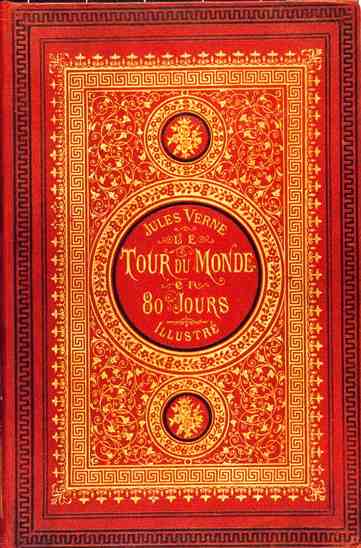
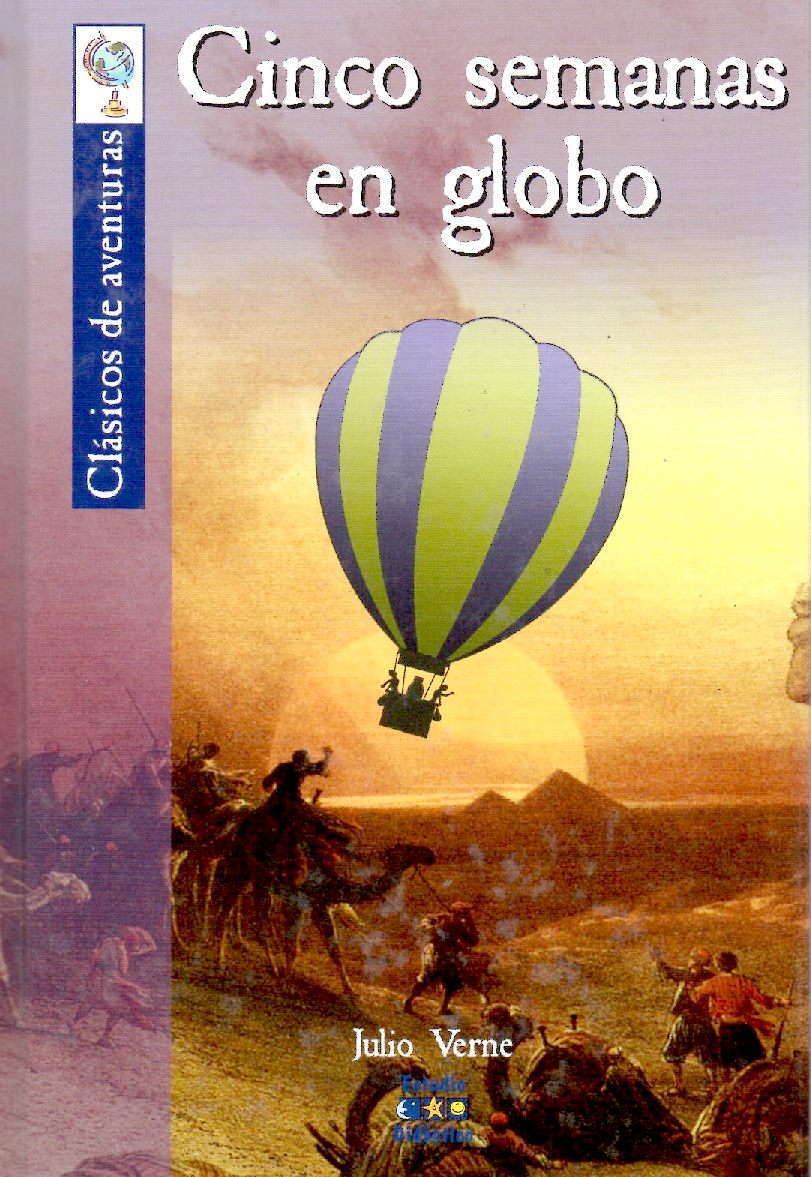
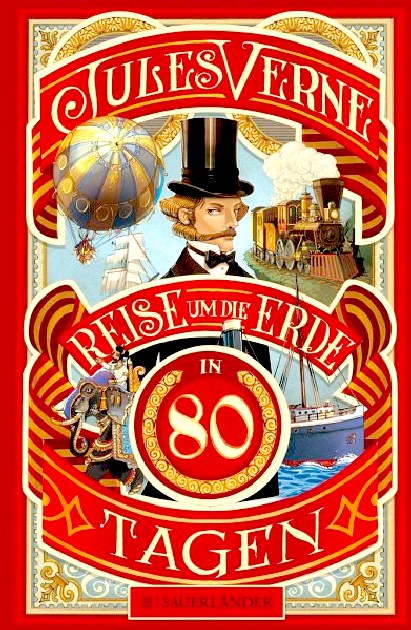
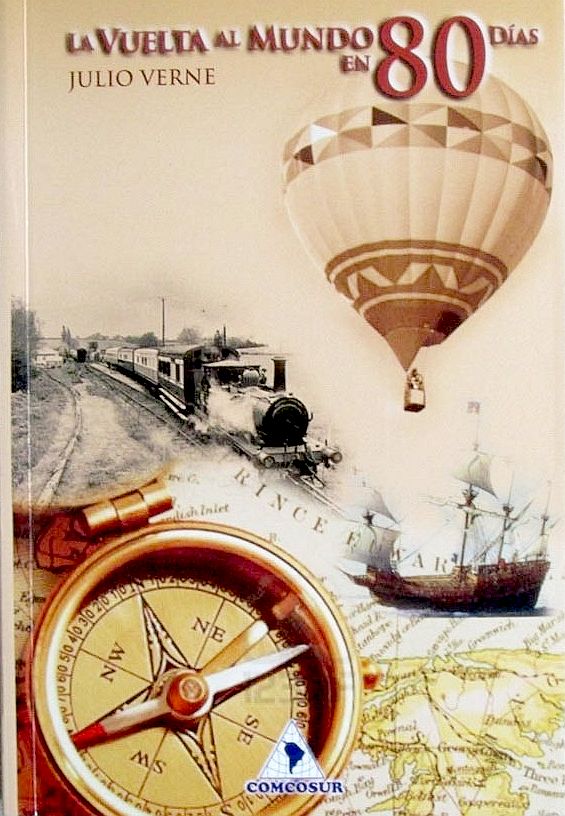

Many
of his stories today seem a little tame, as technology has caught up
with the imagination of the extraordinary French author, and Hollywood
has discovered Computer Generated Images (CGI) allowing super heroes to
grace our screens as never before. Computers are one thing that Verne
did not imagine or seek to portray.
Beginning in late 1872, the serialized version of Verne's famed Around the World in Eighty Days (Le Tour du monde en quatre-vingts jours) first appeared in print. The story of Phileas Fogg and Jean Passepartout takes readers on an adventurous global tour at a time when travel was becoming easier and alluring. In the century plus since its original debut, the work has been adapted for the theater, radio, television and film, including the classic 1956 version starring David
Niven. The TV series starring Pierce Brosnan released in 1989, runs for around 6 hours on
2 DVDs. A BBC
TV travel documentary starring Michael Palin, was also screened in
1989. A second TV series starring David Tennant was produced by the
BBC for 2021.
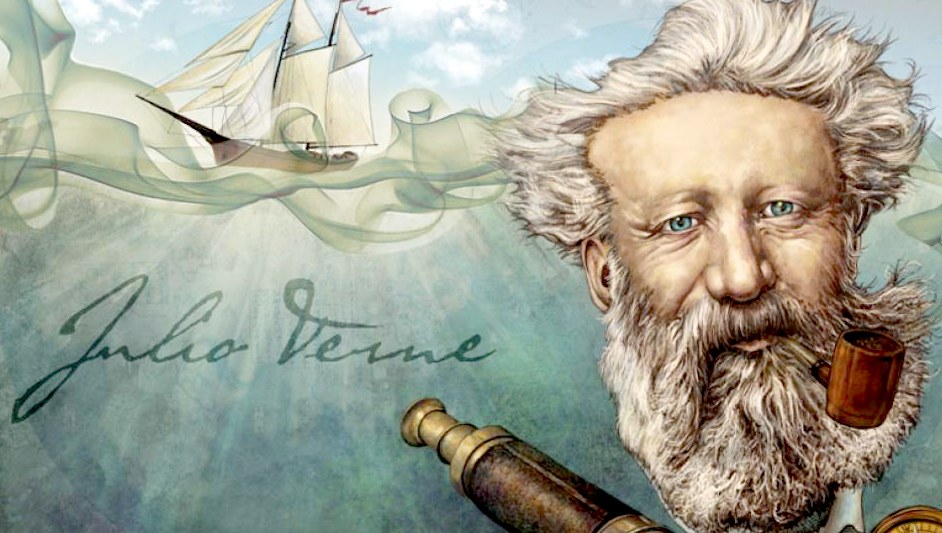
Jules
Verne is known as the Father of Science Fiction
Where
Jules Verne's suggested that it might be possible to travel Around The
World In 80 Days, we would like to extend that ethos to include
traveling in a Zero
Emission yacht (ZEWT or ZEV) driven by electric
hydro-jets? With the advent of solar power and liquid
hydrogen, it is a distinct possibility - on a scale of the wager
that the legendary Philleas Fogg entered into at the Reform Club in
1872.
|







